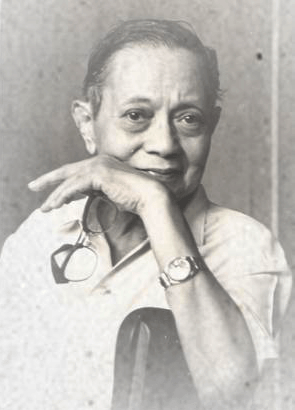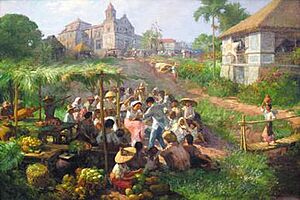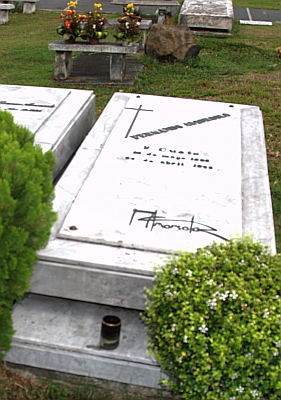Fernando Amorsolo facts for kids
Quick facts for kids
Fernando Amorsolo
|
|
|---|---|
 |
|
| Born |
Fernando Amorsolo y Cueto
May 30, 1892 Paco, Manila, Captaincy General of the Philippines, Spanish Empire
|
| Died | April 24, 1972 (aged 79) Quezon City, Philippines
|
| Resting place | Loyola Memorial Park, Marikina, Philippines |
| Education | University of the Philippines |
| Known for | Painting |
| Spouse(s) |
Salud Tolentino Jorge
(m. 1916; d. 1931)Maria del Carmen (1935–?) |
| Awards | |
Fernando Amorsolo (born May 30, 1892, died April 24, 1972) was a famous Filipino painter. He was known for his beautiful portraits and paintings of Philippine countryside scenes. People called him the "Grand Old Man of Philippine Art." He was the very first artist to be named a National Artist of the Philippines. He earned this honor for his new way of using light in his paintings. His art was important for showing what it meant to be Filipino.
Contents
Early Life and Education
Fernando Amorsolo was born on May 30, 1892, in Metro Manila. His parents were Pedro Amorsolo and Bonifacia Cueto. When Fernando was young, his family moved to Daet, Camarines Norte. They lived there until his father passed away when Fernando was 11 years old. He went to a public school in Daet, but his parents also taught him to read and write Spanish at home.
After his father died, Fernando and his family moved back to Manila. They stayed with his uncle, Don Fabián de la Rosa, who was also a famous Filipino painter. When Fernando was 13, he became his uncle's helper. De la Rosa later became a mentor and guide for Amorsolo's painting career. During this time, Fernando's mother earned money by doing embroidery. Fernando helped by selling watercolor postcards to a local bookstore for 10 centavos each. His younger brother, Pablo Amorsolo, also became a painter.
Fernando Amorsolo had his first success as a young artist in 1908. His painting Leyendo el periódico won second place in a contest called Bazar Escolta. From 1909 to 1914, he studied at the Art School of the Liceo de Manila. His best work there was a painting of a young man and woman in a garden. It won him first prize when he graduated.
After graduating from the Liceo, he went to the University of Santo Tomas' School of Fine Arts. His uncle, De la Rosa, taught there. While in college, Fernando Amorsolo was inspired by many great painters. These included Diego Velázquez, John Singer Sargent, Anders Zorn, Claude Monet, and Pierre-Auguste Renoir. He was especially influenced by Spanish masters like Joaquín Sorolla Bastida and Ignacio Zuloaga. To earn money for school, Amorsolo joined art competitions. He also drew pictures for different Philippine books and magazines. He drew for Severino Reyes’ novel Parusa ng Diyos ("Punishment of God") and Iñigo Ed. Regalado's Madaling Araw ("Dawn"). He also illustrated editions of the Pasyon. Amorsolo graduated with honors from the University of the Philippines in 1914.
Painting Career

After finishing university, Amorsolo worked as a draftsman for the government. He also became a chief artist at the Pacific Commercial Company. He taught art part-time at the University of the Philippines for 38 years. For 14 of those years, he was the director of the Art Department.
After three years of teaching and working as a commercial artist, Amorsolo received a special grant. Filipino businessman Enrique Zóbel de Ayala gave him money to study at the Academia de San Fernando in Madrid, Spain. For seven months in Spain, Amorsolo sketched in museums and on the streets of Madrid. He experimented with how to use light and color in his art. Thanks to the Zóbel grant, Amorsolo also traveled to New York City. There, he saw new art styles like impressionism and cubism. These styles greatly influenced his own work.
When Amorsolo returned to Manila, he opened his own art studio. He painted many works during the 1920s and 1930s. His painting Rice Planting (1922) became very famous. It appeared on posters and tourist brochures for the Commonwealth of the Philippines. Starting in the 1930s, Amorsolo's art was shown in many places in the Philippines and other countries.
Important Filipinos like Luis Araneta and Jorge B. Vargas wanted Amorsolo to paint for them. He was so popular that he had to take photos of his paintings. He would put them in an album so people could choose which ones they wanted. Amorsolo would change small details in his paintings so they were not exact copies.
His art also appeared on the covers of children's textbooks and in novels. He created designs for businesses, cartoons, and illustrations for Philippine magazines. Some of these magazines were The Independent, Philippine Magazine, and Excelsior. He was the director of the University of the Philippine's College of Fine Arts from 1938 to 1952.
From the 1950s until he died in 1972, Amorsolo painted about 10 paintings each month. In his later years, he faced health problems like diabetes and arthritis. The death of two of his sons also affected him. Even after a cataract operation at age 70, he continued to draw and paint.
Amorsolo was a good friend of the Filipino sculptor Guillermo Tolentino. Tolentino created the monument of Filipino hero Andrés Bonifacio in Caloocan.
Art Style and Techniques
Women and Landscapes
Amorsolo is best known for his bright and sunny landscape paintings. These often showed traditional Filipino customs, culture, festivals, and daily life. His paintings of the countryside helped create a sense of Filipino identity. He wanted to show a Filipino version of ideal human beauty. In his paintings of Filipina women, Amorsolo chose Filipino ideals of beauty. He often based the faces of his subjects on members of his own family.
Amorsolo used natural light in his paintings. He developed a special technique called backlighting, which became his artistic signature. In a typical Amorsolo painting, figures have a bright glow around them. Strong light on one part of the painting makes nearby details stand out. Philippine sunlight was always present in Amorsolo's work. It is believed he only painted a rainy-day scene once.
Sketches
Amorsolo loved to sketch. He often drew at his home, at Luneta Park, and in the countryside. He drew the people he saw around him, from farmers to city people during the Japanese occupation. His sketches showed his impressionistic style very well. His figures were not fully finished; they were more like "suggestions" of the image.
Historical Paintings and Portraits
Amorsolo also painted many historical events from before and during Spanish rule. His painting Making of the Philippine Flag was copied many times. For his painting The First Baptism in the Philippines, he made many detailed sketches. He carefully planned all the parts before painting them on the final canvas. To paint scenes from early Philippine history, Amorsolo read accounts from Antonio Pigafetta and other books. He also talked with Filipino scholars like H. Pardo de Tavera and Epifanio de los Santos. His historical works, especially Confeccion de la Standarte Nacionale (Making of the Philippine Flag) from 1955, are very popular. They are often seen on commercial products and are a big part of Filipino culture.
Amorsolo also painted oil portraits of important people. These included Presidents like General Emilio Aguinaldo, Manuel L. Quezon, and Elpidio Quirino. He also painted other famous individuals and even a wedding picture for a prominent couple. He painted a portrait of American Senator Warren Grant Magnuson.
World War II-era Works
When World War II began, Amorsolo's peaceful countryside scenes changed. He started painting scenes of a country damaged by war. During the Japanese occupation of the Philippines, Amorsolo stayed at his home near a Japanese garrison. From his windows or rooftop, he sketched war scenes.
During the war, he showed the destruction of many famous places in Manila. He also painted the sadness, tragedy, and death that Filipinos experienced. His subjects included "women mourning their dead husbands" and "people leaving a dark burning city." Amorsolo often showed the lives and suffering of Filipina women during World War II. Other war paintings by Amorsolo included a portrait of General Douglas MacArthur and paintings of Japanese soldiers. In 1948, Amorsolo's wartime paintings were shown at the Malacañang Palace.
Critical Views of His Art
Many people who supported Amorsolo believed his paintings of the countryside truly showed the "Filipino Soul."
However, some critics said Amorsolo's art became too commercial. They felt he just made souvenir paintings for American soldiers. Critic Francisco Arcellana wrote in 1948 that Amorsolo's paintings "have nothing to say." He felt they were not hard to understand because "there is nothing to understand." Some critics did not like his portraits of famous people or his large historical paintings. They said his "artistic temperament was simply not suited" for creating dramatic historical scenes.
Another critic, however, argued that Amorsolo's best works should be judged, not his less impressive ones. Amorsolo's small landscape paintings, especially from his early career, are often seen as his best. He is considered a master of the Philippine landscape. Some even say he was better at landscapes than Juan Luna and Félix Resurrección Hidalgo.
Death and Legacy
Fernando Amorsolo passed away from heart failure on April 24, 1972. He was 79 years old and had been in St. Luke's Hospital in Quezon City for about two months.
Four days after he died, Amorsolo was honored as the first National Artist of the Philippines at the Cultural Center of the Philippines.
It is believed that Amorsolo created more than 10,000 paintings, sketches, and studies. He had a big impact on Filipino art and artists. His influence can be seen in many landscape paintings by other Filipino artists, including early works by abstract painter Federico Aguilar Alcuaz.
In 2003, Amorsolo's children started the Fernando C. Amorsolo Art Foundation. This foundation works to keep his legacy alive, promote his art style, and preserve his works as a national treasure.
Auction Records
Since the 2000s, Amorsolo's paintings have sold for very high prices at auctions. This shows the growth of the Philippine art market. For example, in 2002, an early painting from 1915 called Portrait of Fernanda de Jesus sold for over 19 million Philippine pesos. In 2010, Lavanderas (1923) sold for over 20 million pesos.
In recent years, local auction houses in the Philippines have helped increase the value of Amorsolo's works. In 2018, a painting from 1931 called Mango Gatherers sold for a world record price of over 46 million Philippine pesos. Other works by Amorsolo have also sold for over 20 million pesos, showing how much his art is valued.
Museums
The Jorge B. Vargas Museum and Filipiniana Research Center in Manila has a large collection of Amorsolo's artwork.
Major Works
Some of Fernando Amorsolo's most important paintings include:
- Afternoon Meal of the Workers (1939)
- Assassination of Governor Bustamante
- Bataan
- The Bombing of the Intendencia (1942)
- The Burning of Manila (1946)
- Confeccion de la Standarte Nacionale (Making of the Philippine Flag) (1955)
- Dalagang Bukid (1936)
- Defense of a Filipina Woman's Honor (1945)
- The First Baptism in the Philippines (1949)
- Fruit Gatherer (1950)
- Maiden in a Stream (1921)
- The Mestiza (1943)
- Planting Rice (multiple versions)
- Rice Planting (1922)
- Sunday Morning Going to Town (1958)
Awards and Achievements
Fernando Amorsolo received many awards for his art:
- 1908 – 2nd Prize, Bazar Escolta for Levendo Periodico
- 1922 – 1st Prize, Commercial and Industrial Fair in the Manila Carnival
- 1929 – 1st Prize, New York's World Fair, for Afternoon Meal of Rice Workers
- 1940 – Outstanding University of the Philippines Alumnus Award
- 1959 – Gold Medal, UNESCO National Commission
- 1961 – Rizal Pro Patria Award
- 1961 – Honorary Doctorate in the Humanities, from the Far Eastern University
- 1963 – Diploma of Merit from the University of the Philippines
- 1963 – Patnubay ng Sining at Kalinangan Award, from the City of Manila
- 1963 – Republic Cultural Heritage Award
- 1972 – Gawad CCP para sa Sining, from the Cultural Center of the Philippines
In 1972, Fernando Amorsolo became the first Filipino to be named the Philippine's National Artist in Painting. He was called the "Grand Old Man of Philippine Art" at the opening of the Manila Hilton's art center on January 23, 1969, where his paintings were shown.
Major Exhibitions
Amorsolo's art was shown in many places outside the Philippines. He had exhibitions in Belgium and at the Exposicion de Panama in 1914. He had a solo show at the Grand Central Art Galleries in New York City in 1925. His art was also displayed at the National Museum in 1948. At the 1931 Paris Exposition, Amorsolo showed his painting The Conversion of the Filipinos. In 1950, he exhibited two more historical paintings, Faith Among the Ruins and Baptism of Rajah Humabon, at the Missionary Art Exhibit in Rome. In 1979, an exhibition celebrated Fernando Amorsolo's art at the Art Center of the Manila Hilton. His art was also featured in an exhibition in Havana in 2007.
Personal Life
Fernando Amorsolo had a large family. Six of his children also became artists.
|
See also
 In Spanish: Fernando Amorsolo para niños
In Spanish: Fernando Amorsolo para niños
- Arts of the Philippines
- Ginebra San Miguel
- José Honorato Lozano
- Juan Luna
- Fabián de la Rosa
- Boxer Codex
- Justiniano Asuncion
- Félix Resurrección Hidalgo


